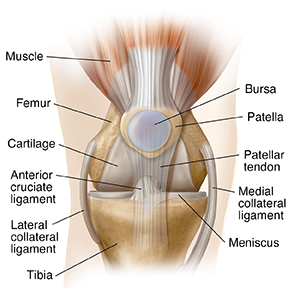Knee Pain and Problems
Brief anatomy of the knee
The knee is a vulnerable joint. It bears a great deal of stress from everyday activities, such as lifting and kneeling, and from high-impact activities, such as jogging and aerobics.
The knee is formed by these parts:
-
Tibia. This is the shin bone or larger bone of the lower leg.
-
Femur. This is the thighbone or upper leg bone.
-
Patella. This is the kneecap.
Each bone end is covered with a layer of cartilage that absorbs shock and protects the knee. Basically, the knee is two long leg bones held together by muscles, ligaments, and tendons.
There are two groups of muscles involved in the knee. The quadriceps muscles are located on the front of the thighs. They straighten the legs. The hamstring muscles are located on the back of the thighs. They bend the leg at the knee.
Tendons are tough cords of tissue that connect muscles to bones. Ligaments are elastic bands of tissue that connect bone to bone. Some ligaments in the knee provide stability and protection of the joints. Other ligaments limit forward and backward movement of the tibia (shin bone).

What are some common knee problems?
Many knee problems are a result of the aging process and continual wear and stress on the knee joint (such as arthritis). Other knee problems are from an injury or a sudden movement that strains the knee. Common knee problems are:
-
Sprained or strained knee ligaments or muscles. A sprained or strained knee ligament or muscle is usually caused by a blow to the knee or a sudden twist of the knee. Symptoms often include pain, swelling, and trouble walking.
-
Torn cartilage. Trauma to the knee can tear the menisci. These are pads of connective tissue that act as shock absorbers and also enhance stability. Cartilage tears can often occur with sprains. Treatment may involve wearing a brace during an activity to protect the knee from further injury. Surgery may be needed to repair or remove the tear.
-
Torn ligaments. When a blow to the knee is bad enough, it can cause a complete tear to the ligaments. This injury most often occurs to the ACL (anterior cruciate ligament). Other ligaments that can tear are the PCL (posterior cruciate ligament), MCL (medical collateral ligament), and the LCL (lateral collateral ligament).
-
Bursitis. This is when a bursa becomes inflamed. A bursa is a fluid-filled sac that helps a joint move. Direct trauma to a bursa or repetitive pressure, such as lengthy kneeling, can cause bursitis.
-
Tendonitis. Inflammation of the tendons may result from overuse of a tendon during certain activities, such as running, jumping, or cycling. Tendonitis of the patellar tendon is called jumper's knee. This often occurs with sports, such as basketball, where the force of hitting the ground after a jump strains the tendon.
-
Arthritis. Osteoarthritis is the most common type of arthritis that affects the knee. Osteoarthritis is a degenerative process where the cartilage in the joint gradually wears away. It often affects middle-age and older people. Osteoarthritis may be caused by excess stress on the joint, such as repeated injury or being overweight. Rheumatoid arthritis can also affect the knees by causing the joint to become inflamed and by destroying the knee cartilage. Rheumatoid arthritis often affects people at an earlier age than osteoarthritis.
How are knee problems diagnosed?
Your healthcare provider will ask about your medical history and do a physical exam. You may also need these tests for knee problems:
-
X-ray. This test uses invisible electromagnetic energy beams to make images of internal tissues, bones, and organs onto film.
-
MRI. This test uses large magnets, radiofrequencies, and a computer to make detailed images of organs and structures within the body. MRI can often find damage or disease in a surrounding ligament, tendon, or muscle.
-
CT scan. This test uses X-rays and computer technology to make detailed images of any part of the body, including the bones, muscles, fat, and organs. CT scans are more detailed than general X-rays.
-
Arthroscopy. This is a minimally-invasive procedure used for conditions of a joint. It uses a small, lighted, optic tube (arthroscope). The tube is inserted into the joint through a small incision in the joint. Images of the inside of the joint are projected onto a screen. It is used to evaluate changes in the joint to find bone diseases, arthritis, cartilage tears, ligament tears, and tumors. It can also determine the cause of bone pain and inflammation.
-
Radionuclide bone scan. This imaging test uses a very small amount of radioactive material. It is injected into the person's bloodstream to be found by a scanner. This test shows blood flow to the bone and cell activity within the bone.
Online Medical Reviewer:
Rahul Banerjee MD
Online Medical Reviewer:
Raymond Turley Jr PA-C
Online Medical Reviewer:
Stacey Wojcik MBA BSN RN
Date Last Reviewed:
9/1/2023
© 2000-2025 The StayWell Company, LLC. All rights reserved. This information is not intended as a substitute for professional medical care. Always follow your healthcare professional's instructions.